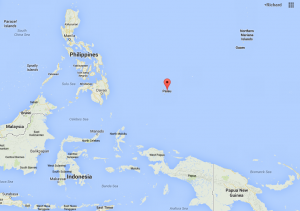Peleliu is part of the Caroline Island Archipelago, the largest of which is the Island of Palau.
In September of 1944, American military planners settled on Peleliu as the next invasion target as they island hopped towards Japan. The island had a functioning runway which gave it some strategic importance, but this invasion has gone down in history as one of the ones that historians often cite as being an avoidable waste of lives. Measuring just 6 square miles, Peleliu has gone down in history as one of costliest battles of the Pacific with more than 2,000 Americans and 10,000 Japanese soldiers killed in the Battle that lasted 73 days.
The Japanese, changing tactics after studying their previous defeats where they tried to engage the invading Americans on the beaches, decided to allow uncontested beach landings. Their new plan was to attack from dug-in positions once the Americans had come ashore. The entire island was turned into a maze of underground bunkers and camouflaged firing positions. Unfortunately the attacking Americans knew nothing about this and walked into a murderous cross-fire.
In a lesson that might well be remembered by our current government as they discuss the effectiveness of bombing ISIS, the US military launched a massive air attack on Peleliu in the week before September 15. Firing on this tiny 6 sq. mile island were the battleships Pennsylvania, Maryland, Mississippi, Tennessee and Idaho, heavy cruisers Columbus, Indianapolis, Louisville, Minneapolis, and Portland, and light cruisers Cleveland, Denver and Honolulu. The bombardment from these ships only stopped so that planes from 19 aircraft carriers of various sizes could drop bombs on the island. In excess of 10,000 tons of shells and bombs slammed into the island. The Admiral in charge thought for sure that no Japanese could survive to fight effectively. The reality was that hardly a single Japanese soldier had been killed because of the depth of the caves in which they had taken refuge. The Japanese planes at the airfield were destroyed but none of the underground fortifications were knocked out, leaving the Japanese completely ready to ambush the US forces as they landed on the island.
On D-Day, the Marines who piled into their landing craft were in for a nasty surprise. As the landing craft approached the beaches, the Japanese opened fire from fortified positions from above and at both ends of the beach, catching the Marines into a murderous crossfire. In less than 1 hour, more than 60 landing craft were destroyed. After the first day, the Marines held 2 miles of beach and little else, at a cost of 1,100 men. Somehow, the Marine commanders still thought that the Japanese were all but defeated and that they would crumble at any second.
72 days later, the island was declared as having been cleared of Japanese.
One interesting thing happened on Peleliu that was to have great impact on future island invasions and eventually on how battles would be fought in Europe. The fighting was so difficult on Peleliu and the Marines on the ground became so frustrated with their commanders that they decided to finally take matters into their own hands. Its hard to believe given today’s technology but in 1944, the men on the ground had no way to communicate directly with the hundreds of aircraft buzzing above their heads. The pilots in their fighters were sent out to look for Japanese targets on the ground but were often afraid to fire near the front lines for fear of hitting their own troops. At the time, the only communication from ground to air was accomplished by placing large orange panels, often shaped like an arrow, which would point towards the Japanese position. No one thought to provide a radio with a direct link from the fighting ground troops directly to the pilots in their planes. Radio communications went back to the offshore ships, then from Marine radio operators to Naval Aviation radiomen and then back to the planes. This took about 5 minutes and if the pilot had a question, another 10 minutes to ask his question and then get his answer.
On Peleliu the Marines and Navy Pilots came up with the solution. Pilots with radios were sent onto the island to act as forward air controllers. Pilots volunteered for this duty because they first thought that only a pilot could give precise enough instructions to other pilots about where to bomb to avoid friendly fire casualties. Eventually the job of a forward air controller was devised and training provided so that Army and Marine radiomen could provide the quick instructions. In retrospect, it seems hard to believe that this was not already standard practice. This fast communication with the ability to quickly hit targets proved very successful and became common practice as the island hopping campaign continued on to Saipan, Iwo Jima and Okinawa.
8 Congressional Medals of Honor were awarded to the men on Peleliu. Only 1 lived to receive the medal in person.
The Commanding General of the Marines on Peleliu (General Roy Geiger) was one of America’s great fighting Generals of the War. He was in command on Guadalcanal in the fall of 1942 and again in charge of the invasion of Guam during July of 1944. And then again in Peleliu in September of 1944. Geiger then led the Marines on Okinawa in June of 1945 and assumed command of the Tenth Army when Army General Simon Bolivar Buckner was killed in action. To this day, Geiger is the only Marine officer to command a US Army in the field.
